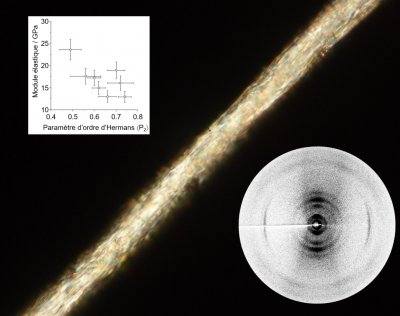Mankind’s relationship with fibres goes back thousands of years, but in the last century we have moved beyond natural plant and animal-based yarns (silk, wool) to develop stronger, more versatile engineered materials (nylon, kevlar).
Artificial nanotube fibres are one-dimensional macroscopic assemblies. To date, most studies have focused on carbon nanotubes fibres due to their potential for high strength and conductivity. However, carbon nanotubes processing by wet spinning has proven to be particularly challenging given their poor solubility. Researchers of Imperial College and Laboratoire de Physique des Solides have chosen to consider imogolite nanotubes [1], an appealing inorganic analogue of carbon nanotubes, but which are hydrophilic enabling simple solution processing.
The synthesis procedure of imogolite nanotubes has been adapted to produce longer nanotubes than those obtained up to now. On this basis, continuous macroscopic fibres of pure imogolite nanotubes were prepared for the first time. Interestingly, in contrast to typical models of carbon nanotubes yarns, a degree of misorientation appears to improve mechanical load transfer between the individual imogolite nanotubes, likely due to an increase in the number of interparticle contacts. Moreover, the tensile strength and modulus of the fibres increase drastically from 20 to 155 MPa and 2.7 to 30 GPa, respectively, when reducing relative humidity from 85 to 10%. These results highlight not only the importance of inter-nanotube interactions in imogolite nanotubes assemblies but also the relevance of controlling shear interactions in nanomaterial fibres in general.

Reference
Continuous binder-free fibers of pure imogolite nanotubes
J.F. Moore, E. Paineau, P. Launois and M.S.P. Shaffer
ACS Applied Materials and Interfaces Manuscript
DOI: 10.1021/acsami.1c00971
Contacts
Erwan Paineau | erwan-nicolas.paineau@universite-paris-saclay.fr
Pascale Launois | pascale.launois@universite-paris-saclay.fr
[1] E. Paineau and P. Launois, Nanomaterials From Imogolite: Structure, Properties, and Functional Materials. In Nanomaterials from Clay Minerals; Elsevier, 2019; pp 2
